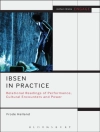Provides a diachronic view of Asian German film history from early Orientalism to increasing collaboration as well as exploration of difference and alternate forms of national and cultural belonging.
From re-creating seedy opium dens and Hindu temples on set to capturing dazzling sights of Tokyo’s neon-lit streets and Berlin’s bustling Dong Xuan Center on location, cinema has provided German-speaking audiences a window into the ‘exotic’ cultures of Asia since the early 1900s. Over time, unilateral German imaginings of Asian cultures and people increasingly gave way to collaboration with Asian countries and more variegated portrayals of the diasporic experiences of Asians in Europe, though Orientalist tropes have not been fully mitigated.
The present volume embraces several understudied regions of Asia as well as Austria and Switzerland. It incorporates archival research, close scene analyses, and genre overviews that elucidate the production and reception histories of individual films, drawing on the knowledge of film historians, cultural studies scholars, and Germanists based in North America, Europe, and Asia. The volume approaches film history by observing three distinct phenomena: early German cinematic imaginings of Asia, co-productions shot on location, and representations of the Asian German diaspora. The book aims to chart unwritten chapters of film history by pitching new readings of old masterpieces, exploring lesser-known works of prolific directors, and uncovering the roles of Asian collaborators from the early twentieth century to the new millennium.
قائمة المحتويات
Acknowledgments
Introduction. A Brief History of Asian German Cinema: Themes, Trends, and Modes of Production – Qinna Shen, Zach Ramon Fitzpatrick, and Qingyang Freya Zhou
Part One: (De-)Exoticized, (Dis-)Orientalized: Remapping Early German Imaginings of Asia
1. Ernst Lubitsch’s Sumurun (1920): Between Orientalist Fantasy and Metaphor of Social Revolution – Anjeana K. Hans
2. Asian Leads in Taifun (1933) and Letzte Liebe (1935): Japanese Love Interests on Austrian Screens in the Shadow of the Nazis – Zach Ramon Fitzpatrick
3. From a Condemned Drama to an Unpresentable Film: Boxer Nationalism, German-British Camaraderie, and Rosa Jung in Alarm in Peking (1937) – Qinna Shen
4. Sensuous Dance, Transgression, and Nazi Racial Worldview in Richard Eichberg’s Der Tiger von Eschnapur and Das indische Grabmal (1938) – Isabella Schwaderer
Part Two. Cooperative, Appropriative: Projecting Asia in Transnational Collaborations from the Third Reich through the Cold War
5. Transnational Encounters, National Desires: Richard Angst and the German-Japanese Mountain Sports Film Das heilige Ziel (1938) – Iris Haukamp
6. Idealism, Instrumentalism, and Race in East German Feature Co-Productions with Mongolia, Vietnam, and India – Evan Torner
7. Remaking German Film History ‘Behind the Bamboo Curtain’: Artur Brauner and William Dieterle’s Herrin der Welt (1960) – Tobias Nagl and Janelle Blankenship
8. ‘Hard-Hitting Karate Action, Humor, and Sex’: How Shaw Brothers from Hong Kong and Rapid-Film from Munich Teamed up in the Seventies and Rode the Eastern Wave – Philipp Stiasny
Part Three. Dynamic, Reflective: Diaspora and Identity in Contemporary Asian German Representations
9. Nomadic Strangers: Asian and European Travelers in German and Austrian Road Movies from the 1970s to the Present – Oliver C. Speck
10. Precarious Kinship, Conflicting Memories, and Ambivalent Affects of Belonging in Cho Sung-hyung’s Korean-German Documentaries – Qingyang Freya Zhou
11. Locating Vietnamese (East) German Lives in the Children’s Film Ente gut! Mädchen allein zu Haus (2016) – Mita Banerjee
12. Fighting Racism or Multikulti-Washing? Asian Germans in Krimis across Public Broadcasting Media – Sabine von Dirke
Notes on Contributors
Index
عن المؤلف
Anjeana K. Hans is Associate Professor of German Studies at Wellesley College.












